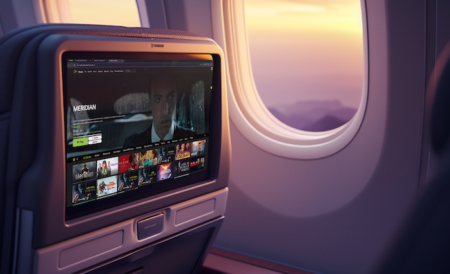
Some 45% of passengers won’t remain loyal to their preferred airline if it doesn’t provide the best wi-fi. That is a finding from a recent Honeywell survey of more than 1,000 Americans who have used inflight wi-fi in the past 12 months. Of those passengers, 68% said they book their flights based on wi-fi availability, and a whopping 84% said it’s important for inflight wi-fi to offer an experience “identical to what they have at home or in the office”. Any way you look at it, that’s a tall order, especially for airlines who have already been struggling to keep up with tech-savvy passengers’ demand for faster, stronger connection speeds to run their increasingly data-hungry apps, games and AR/VR devices of choice during flights.
Hoping to get a better handle on exactly what sort of mobile apps and/or devices will be taking flight with passengers in the not-too-distant future, and how airlines can best prepare themselves for the data-gobbling, new media onslaught to come, we asked some of the industry’s leading tech trend soothsayers to look into their virtual crystal balls and tell us what they see. And the results might just surprise you.
For while boosting wi-fi connection speeds is obviously a given, Emmy award-winning Transmedia producer/new media pioneer Jay Bushman says the first thing airlines need to do is take a cue from the old Apple slogan and “think different”.
New media state of mind
“The internet, mobile, smartphone and tablet revolutions have utterly changed the way people consume information and entertainment. The industry has been very slow to adapt to this new playing field, and most of their attempts can be lumped together as attempts to jam the old ways of doing things into new platforms,” explains Bushman.
“What is required and what is in short supply is an appetite for risk and the ability to back a number of projects and approaches without requiring a guarantee of success. New media is, by definition, new and uncertain. And most of the airlines and big entertainment companies are dedicated to mitigating risk and not rocking the boat.”
Bushman says this approach flies directly in the face of what younger, app-happy passengers, and especially millennials, are looking for in a connected aircraft.
Veteran travel industry analyst and Atmosphere Research Group founder Henry Harteveldt seems to agree. “The types of apps will likely be similar to what we see now: gaming, entertainment, social media, communication, productivity, retail and travel. However, it will be how those apps work that will be different. This isn’t about the connected aircraft, it’s about the connected consumer,” says Harteveldt. “Video will be increasingly important, as will ‘conversational commerce’ using natural language processing (think Siri or Amazon Echo), text/SMS and chat. Location-based communication, aided by beacons and other types of technology will also enable greater precision.”
And with insanely popular AR apps like Pokémon GO already revolutionizing the way we think about mobile gaming, Harteveldt says the lines between the virtual world and the real world will continue to blur in flight.
The virtual conference room
“Virtual reality will, in time, become a major factor [for airlines], especially as VR devices become less expensive, smaller, and more aesthetically attractive. But it won’t all be fun and games. Business travelers will soon want the ability to participate on video calls with colleagues or clients, listen to webinars, and whatever else is required for them to be productive.”
In fact, Patrick Johnson, the director of business development for San Francisco-based AR smartglass firm the Osterhout Design Group (ODG), says the trend to continue to add available bandwidth, both on the ground and in the air, will enable loads of very cool features and apps specifically tailored for business travelers.
“Today’s inflight wi-fi systems support email, which is forgiving in terms of unreliable and slow connections. For example, the original Gogo system supported about 3Mbps for the entire aircraft, while most of those in service now are closer to 10Mbps per airplane. The next generation of systems will do better, aiming to deliver about 70Mbps per airplane,” says Johnson, which could allow for “participation in virtual meetings with material being reviewed in multimedia where the meeting supports collaboration, screen share, 3D model display, and manipulation, etc.”
And although Harteveldt says he also has his eye on next-gen mobile innovations such as rollable tech – super-thin tablets, laptops and other devices that roll into a cylindrical shape – and Johnson predicts a day will soon come when increased bandwidth will afford passengers and crew wearing AR smartglasses the ability to translate inflight safety manuals, magazines and menus into different languages via object recognition software, even Johnson freely admits that some of these things are more than a few years off.
“With the slim profit margins of airlines, I understand why they are slow to move when it comes to adopting new, disruptive technology,” says Johnson. “It is going to be a while before there is any mass adoption of new tech such as smartglasses for airlines, but it won’t be too long before smartglasses become the status quo device for consuming media and entertainment.” So, ultimately, Johnson says it’s going to be passenger demand that gets smartglasses onto the airplane.
Dreaming big
And when it comes to passenger demand, SITA’s director of market insight, Nigel Pickford, says the airlines are definitely listening.
“Mobile and the use of apps is without a doubt the biggest focus area for airlines over the next few years,” says Pickford. “SITA’s Airline IT Trends Survey 2016 indicates that mobile continues to dominate airlines’ IT investment agenda for passenger services. Nearly 80% of airlines plan major investments in passenger services via smartphones over the next three years, while 71% of airlines expect to do the same for tablets. Looking more specifically at the services to be delivered, airlines are using mobile to offer duty-free shopping and other commercial offerings that can be managed from the palm of your hand. Providing personalized information on the move through airline apps is also a huge focus for airlines, helping deliver a more intimate passenger experience.”
 “In their everyday life, passengers are increasingly adopting new technologies such as wearables, artificial intelligence and, to some extent, virtual reality,” adds Pickford. “Airlines are following this trend and increasingly investing in new products using these technologies in the cabin. Among the emerging technologies starting to appear in the industry are passenger wearables, such as smartglasses or smartwatches – which are seen as having the most potential over the next five years. Currently 11% of airlines are in the process of trialling services for these, with another 28% expecting to over the next five years. And in the next 10 years, just over half of airlines (54%) plan to evaluate wearable technology, while 43% will do the same for artificial intelligence (AI).”
“In their everyday life, passengers are increasingly adopting new technologies such as wearables, artificial intelligence and, to some extent, virtual reality,” adds Pickford. “Airlines are following this trend and increasingly investing in new products using these technologies in the cabin. Among the emerging technologies starting to appear in the industry are passenger wearables, such as smartglasses or smartwatches – which are seen as having the most potential over the next five years. Currently 11% of airlines are in the process of trialling services for these, with another 28% expecting to over the next five years. And in the next 10 years, just over half of airlines (54%) plan to evaluate wearable technology, while 43% will do the same for artificial intelligence (AI).”
And although AI apps such as the recently launched social media sensation Candid – which filters out hate speech and “enforces civility” through its algorithmic AI – sound very cool, and the idea of being able to use robot assistant apps like Amazon’s Alexa and the upcoming Viv (from Siri co-creators Dag Kittlaus and Adam Cheyer) in flight will surely appeal to many passengers, Harteveldt says it is important to remember that all of this mobile app awesomeness is contingent on bandwidth.
The future
And according to Gogo’s chief commercial officer, Ash ElDifrawi, that’s not as far off as some might think. “There’s no doubt that there are more and more applications that are being used in flight, and many of them are consuming more and more data. Snapchat is a great example of an application that uses a surprisingly large amount of bandwidth and we are seeing usage increase in flight, especially in the USA,” says ElDifrawi.
“For Gogo, the only real answer to this is to bring more bandwidth to the aircraft and create an experience that is comparable to the ground. As an industry, we are fortunately on the cusp of an era of bandwidth abundance. 2Ku in particular gets us there in terms of delivering lots of bandwidth anywhere an airplane flies. We also have a pathway to bring even more bandwidth with this technology to accommodate the data consumption trends we are experiencing on the ground. The other way we are looking at this is to try and build an environment where we are developing applications and services specific for aviation that are not only more compatible with inflight connectivity, but are unique to the travel experience itself,” ElDifrawi explains.
“The development of unique connected applications and experiences in flight, whether for consumers or airline operations, has always hinged on a few things – an abundance of lower cost bandwidth that’s comparable to what you see on the ground, seamless connectivity anywhere an airplane flies around the world, and a digital platform to allow for application integration with various data points on the aircraft,” says ElDifrawi. “We now have the technology that brings a lot of bandwidth in 2Ku and we’ve built the digital ecosystem where these experiences can be developed. Now, the sky is literally the limit.”
Many airlines do seem to be rising to the challenge, with more than half of the carriers responding to SITA’s Airline IT Trends Survey 2016 reportedly having “major wi-fi projects in the works”, with nearly three-quarters (74%) of them on track to offer inflight wi-fi to their passengers by the end of 2019. However, Pickford says the issue of whether or not the service on offer will be fast enough or come soon enough for some passengers remains to be seen.
In the meantime, Bushman suggests that what airlines should really start thinking about are all the shiny mobile apps and new media gadgetry that hasn’t even been dreamed up yet. “With the proliferation of different devices and screens for consuming entertainment on land and in the air, we’re going to see some radical changes in how entertainment programming is delivered, which will require a whole new language and a whole new framework to evaluate, along with some new business models,” predicts Bushman. “I think we’re about to see an explosion of content of all kinds that will totally rewrite the rules.”
In other words, to steal a line from my new Oscar Wilde daily quote app, “Expect the unexpected.”




